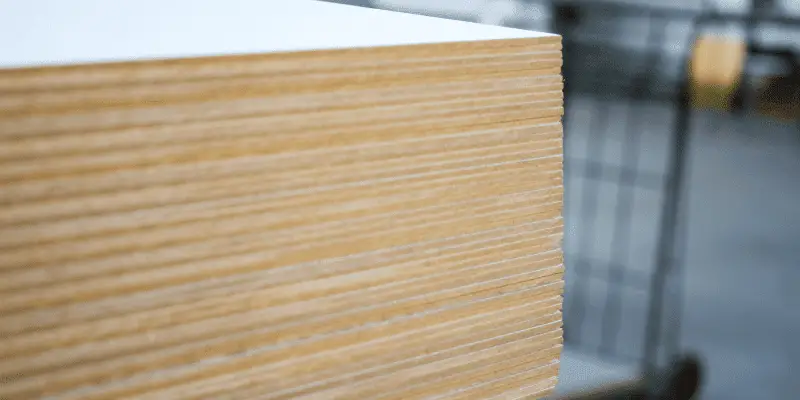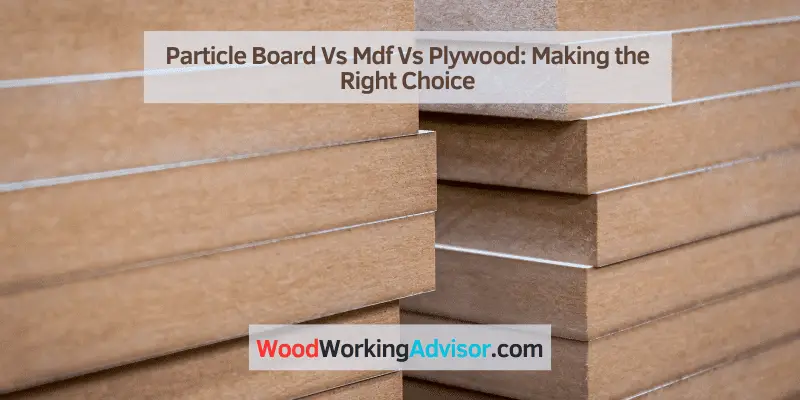Particle board, MDF, and plywood are commonly used in furniture and cabinetry. Each material has its own strengths and weaknesses.
Understanding the differences between them can help you make an informed choice for your project. Particle board, also known as chipboard, is made from wood particles bonded with resin. It’s affordable but less durable and prone to moisture damage. MDF, or medium-density fiberboard, is made from wood fibers and resin.
It’s smoother and more uniform than particle board, but also susceptible to moisture. Plywood is made from veneer sheets bonded together, offering strength and moisture resistance, but at a higher cost. We’ll explore the characteristics of these materials, their common uses, and key factors to consider when deciding which one is best for your project.
Properties And Composition
When it comes to choosing the right type of engineered wood for your project, understanding the properties and composition of particle board, MDF, and plywood is crucial. Each material has its unique characteristics and applications, so it’s essential to grasp the differences to make an informed decision. Let’s delve into the properties and composition of particle board, MDF, and plywood to help you choose the best option for your specific needs.
Particle Board
Particle board, also known as chipboard, is a composite material that consists of wood chips or shavings bonded together with a resin or glue under high pressure and heat. The composition typically includes wood particles, adhesive, and often additional substances such as wax and other chemicals to enhance specific properties. Here are the key properties and composition of particle board:
- Density: Generally lower density compared to MDF and plywood
- Strength: Offers less strength and durability compared to MDF and plywood
- Surface Finish: Smooth surface, suitable for laminating or veneering
- Composition: Wood particles, resin or glue, and sometimes additional additives
Mdf
MDF (Medium Density Fiberboard) is an engineered wood product made by breaking down hardwood or softwood residuals into wood fibers, often in a defibrator, combining it with wax and a resin binder, and forming panels by applying high temperature and pressure. Let’s explore the properties and composition of MDF:
- Density: Higher density than particle board, consistent throughout the sheet
- Strength: Offers improved strength and stability compared to particle board
- Surface Finish: Smooth, dense surface, suitable for painting and finishing
- Composition: Wood fibers, resin binder, and wax
Plywood
Plywood is a panel product formed by gluing together thin layers of wood veneers with adjacent layers having their wood grain rotated up to 90 degrees to one another. The number of layers (or plies) and the orientation of the grain of each layer provide inherent strength and stability. Here are the key properties and composition of plywood:
- Density: Varies based on the wood species and intended application
- Strength: Exceptional strength and durability, varying with the quality and type of wood
- Surface Finish: Can have a varied surface finish, depending on the intended use and wood veneer quality
- Composition: Thin wood veneers, adhesive, and sometimes additional materials for specific applications (e.g., marine-grade plywood)
Strength And Durability Comparison
When it comes to choosing the right material for your furniture or construction projects, considering strength and durability is crucial. Particle board, MDF, and plywood are common choices, each with its unique properties and strengths. Let’s delve into a comparison of their strength and durability across different factors.
Resistance To Moisture
Particle board, due to its high resin content, has the lowest resistance to moisture among the three materials. It tends to swell and deteriorate when exposed to water or high humidity. On the other hand, MDF, being denser and more uniform, demonstrates better resistance to moisture compared to particle board. Plywood, constructed from layers of wood veneer bonded together, exhibits the highest resistance to moisture.
Weight-bearing Capacity
Particle board is less strong and stable than MDF and plywood, resulting in a limited weight-bearing capacity. MDF, with its high density and uniform composition, offers better weight-bearing capacity than particle board but is still outperformed by plywood. Plywood, known for its strength and stability, has the highest weight-bearing capacity among the three materials, making it ideal for heavy-duty applications.
Longevity And Wear Resistance
When it comes to longevity and wear resistance, particle board is less durable compared to MDF and plywood. It is more susceptible to dents, scratches, and warping over time. MDF, with its smooth and homogenous surface, offers better resistance to wear and tear, making it a durable choice for furniture and cabinetry. However, plywood, with its layered construction and natural wood properties, surpasses both particle board and MDF in terms of longevity and wear resistance.

Applications And Suitable Uses
When it comes to choosing the right material for your woodworking projects, it’s important to understand the specific applications and suitable uses of particle board, MDF, and plywood. Each material has unique characteristics that make it suitable for different types of projects. Let’s explore the applications and suitable uses of these materials in furniture making, cabinetry, and architectural applications.
Furniture Making
Particle Board: Particle board is commonly used in furniture making, especially for budget-friendly options. It is suitable for constructing shelves, bookcases, and other furniture pieces that don’t require heavy load-bearing capacity. However, it may not be the best choice for furniture that needs to withstand heavy wear and tear.
MDF: MDF is a popular choice for furniture making due to its smooth surface and ability to be shaped and molded easily. It is often used for cabinet doors, drawer fronts, and other furniture components that require intricate designs and detailing.
Plywood: Plywood is known for its strength and durability, making it ideal for furniture that needs to support heavy loads. It is commonly used for constructing tables, chairs, and other furniture pieces that require structural integrity.
Cabinetry
Particle Board: Particle board is often used in the construction of budget-friendly cabinets. It works well for interior components of cabinets such as shelves and drawer bottoms. However, it may not be suitable for areas prone to moisture or heavy use.
MDF: MDF is a preferred material for cabinet construction due to its smooth finish and ability to be painted or laminated. It is commonly used for cabinet doors, drawer fronts, and cabinet boxes.
Plywood: Plywood is widely used for constructing high-quality, durable cabinets. It is suitable for both interior and exterior cabinet components, making it a versatile choice for various cabinet styles and designs.
Architectural Applications
Particle Board: Particle board is not typically used in architectural applications due to its lower strength and susceptibility to moisture damage.
MDF: MDF is often used in architectural applications for interior molding, trim, and decorative paneling. Its smooth surface and ability to hold intricate designs make it an ideal choice for architectural detailing.
Plywood: Plywood finds extensive use in architectural applications for its structural strength and versatility. It is used for subflooring, sheathing, roofing, and other structural elements in building construction.
Environmental Impact And Sustainability
When considering the environmental impact and sustainability of particle board, MDF, and plywood, it’s crucial to delve into their resource utilization, recycling and disposal methods, and eco-friendly manufacturing practices.
Resource Utilization
All three materials, particle board, MDF, and plywood, are created from wood byproducts, making them a sustainable option. Particle board and MDF are mainly composed of wood particles and fibers, while plywood is constructed from thin layers of wood veneer. Due to their efficient use of wood resources, all three materials play a role in minimizing waste and contributing to sustainable forestry practices.
Recycling And Disposal
Particle board, MDF, and plywood can be recycled through different processes. Particle board and MDF can be broken down and reused to create new panels, while plywood can be repurposed into various wood products. However, it’s important to note that the adhesives used in these products can complicate the recycling process. Proper disposal methods are necessary to ensure minimal environmental impact.
Eco-friendly Manufacturing Practices
The manufacturing of particle board, MDF, and plywood involves the use of adhesives and resins, which can pose environmental concerns. Nevertheless, advancements in technology have led to the development of eco-friendly adhesives and manufacturing processes that minimize emissions and reduce environmental impact. Manufacturers are increasingly prioritizing sustainable practices, such as using recycled wood fibers and implementing energy-efficient production methods.
Frequently Asked Questions For Particle Board Vs Mdf Vs Plywood
What Are The Main Differences Between Particle Board, Mdf, And Plywood?
Particle board is made of wood particles bonded by adhesive, MDF comprises wood fibers and resin, while plywood consists of thin layers of wood veneer pressed together in alternating directions. Each material offers its own unique set of strengths and weaknesses, making them suitable for different applications.
Which Is More Durable: Particle Board, Mdf, Or Plywood?
Plywood is generally considered the most durable among the three. Its cross-grain construction provides strength and stability, making it suitable for heavy-duty applications. However, both Particle Board and MDF can be reinforced for increased durability, depending on the specific requirements of the project.
What Are The Best Applications For Particle Board, Mdf, And Plywood?
Particle board is commonly used for furniture, cabinets, and shelving. MDF is preferred for painted surfaces, such as doors and furniture. Plywood is versatile and suitable for various applications, including structural and decorative purposes, as well as exterior use with the right treatment.
Can Particle Board, Mdf, And Plywood Be Used Interchangeably?
While all three materials have similarities, they have distinct properties that make them suitable for different applications. It’s essential to consider factors such as strength, appearance, and cost to determine the most suitable material for a specific project.
Conclusion
Particle board, MDF, and plywood each have their unique strengths and weaknesses. The perfect choice depends on specific project requirements. Prioritize durability, cost-effectiveness, and water resistance. Understanding the distinctions between these materials is crucial for making informed decisions in construction and woodworking projects.
Experiment with various materials to find the best fit.



One thought on “Particle Board Vs Mdf Vs Plywood: Making the Right Choice”